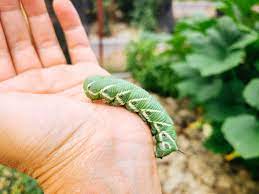By McKayla Davis, Contributing Writer
Few gardening moments are as disheartening as discovering a tomato hornworm munching through your plants. These green pests, notorious for their ability to blend in with foliage, can wreak havoc on your garden if left unchecked. Their voracious appetite for tomato plants and related crops often leaves gardeners feeling frustrated and overwhelmed.
But don’t worry—there’s hope! With the right strategies, you can protect your garden, prevent further damage, and even turn the tide in your favor. In this guide, we’ll walk you through identifying tomato hornworms, immediate solutions to remove them, and long-term preventive measures to safeguard your garden.
What Are Tomato Hornworms?
Tomato hornworms are large caterpillars, reaching 4–5 inches in length, with distinctive white and black markings and a horn-like projection on their rear. Their camouflage makes them difficult to spot, but their damage is unmistakable.
Signs of an Infestation:
- Missing leaves and chewed stems.
- Green or black droppings on or near plants.
- Damaged or partially eaten fruits.
Hornworms primarily target tomato plants but can also attack other members of the nightshade family, such as peppers, eggplants, and potatoes.
Immediate Actions to Save Your Garden
- Handpick Hornworms:
- Don a pair of garden gloves and inspect your plants carefully.
- Remove each hornworm and drop it into a bucket of soapy water to kill it.
- Time Your Inspections:
- Look for hornworms during cooler parts of the day—early morning or late evening—when they are less active and easier to spot.

- Apply Organic Insecticides:
- Use Bacillus thuringiensis (Bt), a naturally occurring bacteria that targets caterpillars without harming beneficial insects. Follow the instructions on the product label for safe application.
Preventing Future Infestations
- Plant Natural Repellents:
- Incorporate marigolds or dill into your garden. These plants repel hornworms and other pests naturally.
- Use Companion Planting:
- Grow basil alongside your tomato plants to deter hornworms and enhance crop health.
- Rotate Crops Annually:
- Prevent hornworms from laying eggs in your soil by planting different crops in your tomato bed each year.
Managing Severe Infestations
- Encourage Natural Predators:
- Introduce beneficial insects like ladybugs and green lacewings, or attract birds to your garden with feeders or birdhouses.
- Consider Chemical Solutions:
- Use chemical insecticides only as a last resort. Ensure you select a product safe for food crops and follow all safety guidelines to minimize environmental impact.
Final Thoughts
Dealing with tomato hornworms requires patience, persistence, and proactive measures. The key is early detection and prompt action. By incorporating preventive strategies and staying vigilant, you can reclaim your garden and enjoy a bountiful harvest.
If you need personalized assistance, reach out to a local agricultural extension office or consult a gardening professional. Remember: a thriving garden starts with informed and attentive care.
This version is concise yet informative, offering actionable advice to readers while maintaining an approachable and empowering tone.
